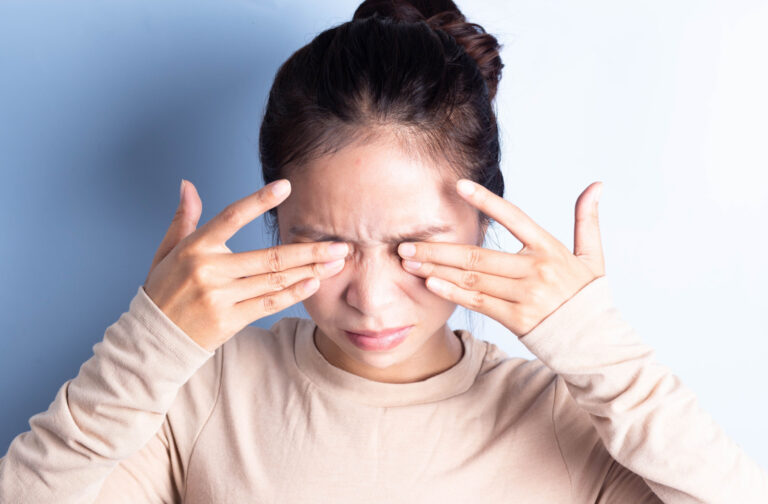Table of Contents

Introduction
Dealing with the discomfort of dry eyes can be more than a minor annoyance. For many, it’s a daily struggle. A clog in your meibomian glands often causes dry eye. So what do you do if you have dry eyes? Can you unclog meibomian glands?
If you’re dealing with dry eyes, it’s time to visit your optometrist to talk about dry eye therapy. We can provide treatment in the form of intense pulsed light, low-level light therapy (LLLT), LipiFlow, or meibomian gland expression—all non-invasive approaches to treating dry eyes and helping you find relief.
What Are Meibomian Glands?
Along the inside of your eyelids, you have tiny little glands. There are about 30-40 in the upper eyelid and about 20-30 in the lower eyelid. These are your meibomian glands, responsible for secreting the oils needed for your tear film.
These oils are essential for maintaining your eye health. The oils produced line the outer layer of your tears, which stops them from evaporating too quickly. This lets your tears do their job of keeping your eyes hydrated and protected.
Sometimes, though, these glands can become plugged or blocked. This stops the oils from reaching the tear film and can start a chain reaction.
What Happens When Meibomian Glands Become Blocked?
When the meibomian glands become blocked, plugged, or impacted in any way, the oils can’t reach your tear film. Your tears evaporate too soon, leaving the eye exposed to the environment. When this occurs, it’s called “meibomian gland dysfunction” or “MGD.”
MGD often leads to inflammation and irritation around your eyes. Because your tears are no longer protecting the eye, you may develop dry eye—a common eye condition that feels like the surface of your eye is dry, gritty, or burning.
This can lead to further inflammation and irritation, making it essential to recognize the signs that something’s wrong in your eye.
How to Tell if Your Meibomian Glands Are Blocked
Clogged meibomian glands often lead to the development of dry eyes, so it’s often recognizable by feelings of grittiness or sandiness in the eye. However, you may also notice:
- Persistent dryness
- A stinging or burning sensation
- Redness and swelling of the eyelids
- Blurred vision, especially after long periods of screen time
- Increased sensitivity to light
- Difficulty wearing contact lenses
- Eye fatigue, even after short visual tasks
- Excessive tearing as a response to the dryness
How to Treat Clogged Meibomian Glands
When you have clogged meibomian glands—or feelings of dry eye—your first step should be to contact your optometrist and book an eye exam. They can comprehensively evaluate your tear film and check to see what’s causing your symptoms.
Then, they’ll likely recommend one of the following types of dry eye therapy:
- Intense pulsed light (IPL) therapy
- LipiFlow
- Low-level light therapy (LLLT)
- Meibomian gland expression
It’s important to note that while the below treatments can help you find relief, they may not produce permanent results. If you experience chronic dry eye, you may need to return for further treatment if the condition flares up.
Intense Pulsed Light (IPL) Therapy 强脉冲光治疗干眼症
IPL is a non-invasive approach often used to treat dry eyes. It uses gentle amounts of pulsed light-based heat to stimulate the area around the meibomian glands. This helps to warm the oils that may be causing the blockages, letting them liquify and flow out. This process typically takes a few minutes and often provides almost immediate relief.
LipiFlow Thermal Pulsation System
LipiFlow is a short procedure that uses a small handheld device to deliver precise, controlled amounts of gentle heat and pressure to the eyelids. This combination helps massage the eyelid and melt any trapped oils near the meibomian glands, letting them flow freely to reach your tear film.
Low-Level Light Therapy (LLLT) 低能量光療法
Low-level light therapy is a gentle in-office treatment that applies specific wavelengths of light to your closed eyelid. These light waves help reduce inflammation and boost the production of natural oils in the meibomian glands. This treatment often works well when combined with other types of dry eye therapy like LipiFlow or IPL. Over time, it can help restore your tear film’s natural balance.
Meibomian Gland Expression

Can You Prevent Meibomian Gland Dysfunction?
While MGD can be frustrating, there is good news: there are steps and small adjustments you can make in your everyday life to help promote healthy meibomian glands. It can help to:
- Stay hydrated throughout the day to support overall eye health
- Use warm compresses to heat the eyelids and encourage oil flow
- Practice good eyelid hygiene, and never touch your eyes without washing your hands
- Take regular breaks during activities that require intense focus to avoid eye strain and promote regular blinking
- Make environmental changes, like using a humidifier, to help maintain moisture in the air and reduce how hard your eyes need to work
- Take omega-3 fatty acid supplements
By incorporating these habits into your routine, you can support the health of your meibomian glands and potentially reduce the risk of developing MGD.
When to Visit Your Optometrist for Dry Eyes
If you’re dealing with dry eyes or have any vision irregularities, contact our team at Golden Vision. We are here to help you find a solution and get you relief from your dry eyes. Don’t let dry eyes hold you back—book an appointment with our team today.

